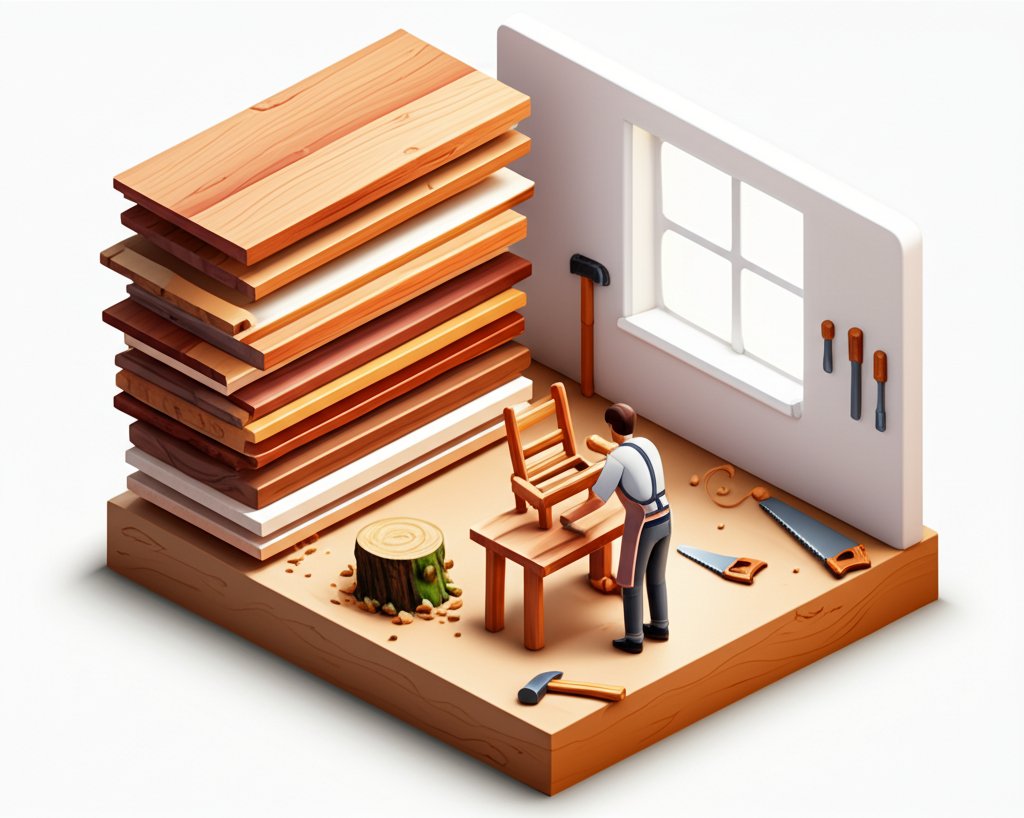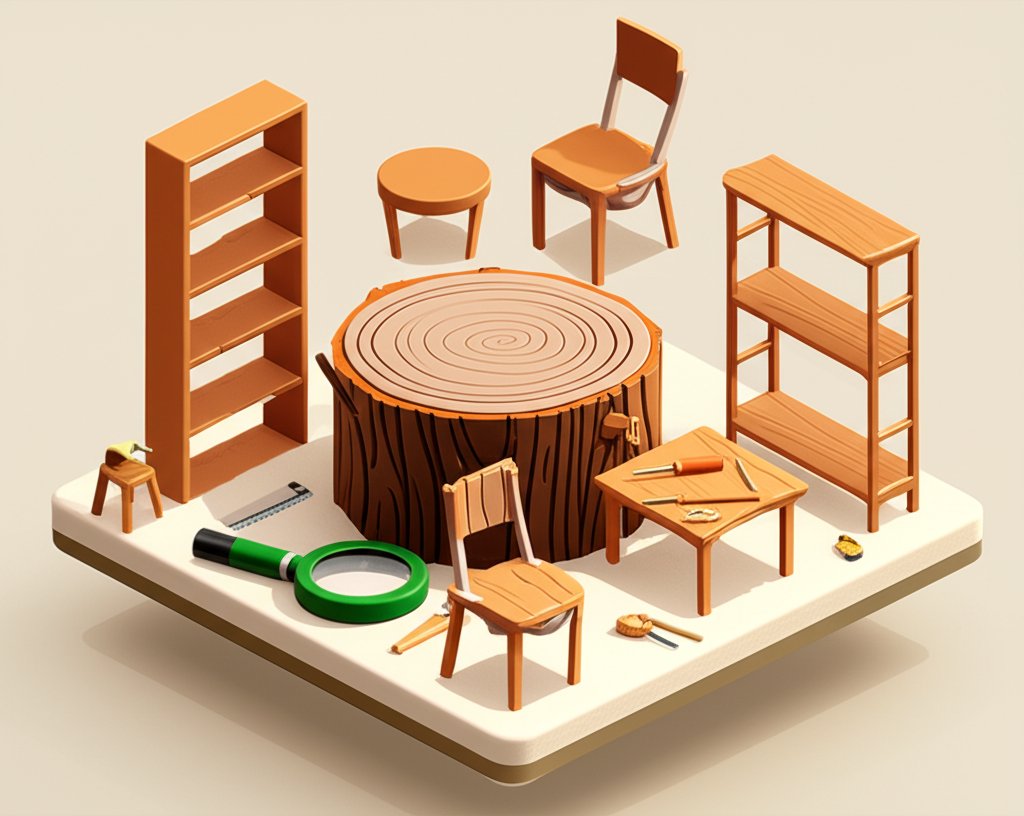Have you ever paused to truly appreciate the enduring beauty and rich history embedded in every grain of wood furniture? Beyond its aesthetic appeal, wood furniture holds a fascinating array of secrets, from its incredible longevity to its environmental impact. As the centerpiece of countless homes and workplaces for millennia, understanding the intricate facts about wood furniture unlocks a deeper appreciation for this remarkable material. This comprehensive guide will not only unveil ten captivating insights but also delve into the diverse jenis kayu untuk furniture, explore innovative desain furniture kayu, and highlight the growing importance of furniture kayu sustainable. Get ready to embark on a journey that reveals why wood remains an unparalleled choice for crafting timeless pieces that enhance our lives.
Beyond Beauty: Unveiling Core Facts About Wood Furniture

Wood furniture is more than just functional decor; it’s a testament to nature’s artistry and human ingenuity. Here are some fundamental facts about wood furniture that highlight its unique attributes:
To further appreciate the artistry, consider the detailed processes involved in furniture creation, expanding on the facts about furniture making and the skilled craftsmanship required.
1. The Enduring Legacy of Longevity and Durability
One of the most compelling facts about wood furniture is its exceptional lifespan. When cared for properly, a piece of wood furniture isn’t just a purchase; it’s an investment for generations. Unlike many modern materials that degrade over time, high-quality wood, especially hardwoods, retains its structural integrity and beauty for centuries. This durability stems from its robust cellular structure, making it resistant to wear and tear. Imagine a solid oak dining table witnessing family meals for hundreds of years – a true testament to wood’s enduring spirit.
2. Nature’s Aesthetic Palette: Grains, Colors, and Aromas
Every piece of wood is unique. The distinct grain patterns, from the straight lines of maple to the intricate swirls of burled walnut, are like nature’s fingerprints, ensuring no two pieces of wood furniture are identical. These patterns, combined with the natural color variations—from the pale cream of birch to the deep reddish-brown of mahogany—offer an unparalleled aesthetic versatility. Moreover, many jenis kayu untuk furniture possess characteristic aromas. Cedar’s sweet, lingering scent, pine’s fresh, resinous perfume, or oak’s subtle, earthy fragrance all contribute a sensory layer that synthetic materials simply cannot replicate, adding warmth and character to any space.
3. A Touch of History: Wood in Civilizations
Wood furniture is deeply woven into the tapestry of human history. From the earliest rudimentary wooden stools to the ornate carvings of Renaissance cabinets, wood has always been humankind’s primary material for crafting domestic essentials. In ancient Egypt, for instance, chairs were not common items but symbols of wealth and power; the higher the legs of the chair, the more exalted the owner’s status. Throughout various eras, desain furniture kayu has mirrored societal changes, artistic movements, and technological advancements, offering a tangible link to our past.
4. The Innovation Curve: From Craft to Mass Production
The evolution of wood furniture is also a story of innovation. While traditional craftsmanship emphasized intricate joinery and hand-carving, the 20th century brought revolutionary changes. A prime example is the birth of flat-pack furniture, pioneered by IKEA in the 1950s after designer Gillis Lundgren struggled to fit a table into his car. This simple act of disassembling legs for transport sparked a revolution in cost-effective, easily transportable, and user-assembleable wood furniture, making quality pieces accessible to a broader audience.
5. Repairability and Refinishing: A Sustainable Cycle
Unlike composite materials or plastics that often require complete replacement when damaged, wood furniture boasts remarkable repairability. Scratches can be buffed out, dents filled, and even broken sections can often be skillfully mended. Furthermore, wood can be sanded down and refinished multiple times throughout its life, allowing for aesthetic changes or restoration to its original glory. This inherent ability to be renewed and repurposed significantly contributes to the sustainability of wood, extending its useful life and reducing waste.
6. Thermal and Acoustic Properties: Comfort and Quiet
Wood is a natural insulator, offering comfort that other materials might lack. It doesn’t conduct heat or cold quickly, meaning a wooden surface feels pleasant to the touch, unlike metal or stone. Beyond temperature, wood possesses excellent acoustic properties. It can absorb sound waves, helping to dampen echoes and create a warmer, quieter, and more inviting ambiance in a room. This makes wood furniture not just visually appealing but also a functional element in creating comfortable living and working environments.
7. Value Appreciation: Antiques and Heirloom Potential
While some furniture depreciates over time, well-crafted wood furniture, particularly pieces made from premium jenis kayu untuk furniture and featuring exceptional desain furniture kayu, can actually appreciate in value. Antiques made from durable woods with historical significance or unique craftsmanship are highly sought after by collectors. Even modern custom pieces hold their value better than mass-produced alternatives, signifying the investment potential that comes with quality wood.
8. The Breathability of Wood
Wood is a hygroscopic material, meaning it naturally absorbs and releases moisture from the air, effectively “breathing.” This property helps regulate humidity levels in a room to some extent, contributing to a more comfortable indoor environment. This interaction with its surroundings also means wood can swell in humid conditions and contract in dry ones, a key consideration for its care and construction.
9. Adaptability with Finishes
The surface of wood can be treated with a vast array of finishes—from natural oils and waxes that enhance its raw beauty to protective lacquers and paints that offer endless color and texture possibilities. These finishes not only protect the wood from moisture, scratches, and UV damage but also allow for immense customization in desain furniture kayu, enabling it to fit seamlessly into any interior style, from rustic farmhouse to sleek contemporary.
10. Environmental Benefits: A Carbon Sink
A crucial fact about wood furniture for the modern era is its role in environmental sustainability. Trees absorb carbon dioxide as they grow, storing it in their wood. When this wood is used for furniture, that carbon remains sequestered, rather than being released back into the atmosphere. This makes wood furniture a natural carbon sink, provided it’s sourced from responsibly managed forests. Choosing furniture kayu sustainable actively contributes to combating climate change.
Choosing Your Timber: Essential Jenis Kayu Untuk Furniture
The selection of jenis kayu untuk furniture is paramount, influencing not only the aesthetic but also the durability, cost, and overall character of the piece. Understanding the distinctions between different woods is key to making informed decisions.
Hardwoods: The Stalwarts of Strength
Hardwoods, typically from deciduous trees (those that lose their leaves annually), are renowned for their density, strength, and longevity. They are excellent choices for wood furniture that needs to withstand heavy use or become an heirloom.
- Jati (Teak): A premier choice, especially for outdoor
furniture kayu sustainabledue to its natural oils that resist water, pests, and decay. Its golden-brown hue darkens beautifully with age. - Mahoni (Mahogany): Known for its rich reddish-brown color, fine grain, and excellent workability. It’s often used for classic and elegant
desain furniture kayu. - Ek (Oak): A very strong and durable wood with prominent grain patterns. Available in red and white varieties, it’s popular for traditional and rustic
wood furniture. - Maple: Hard, dense, and light-colored with a fine, even grain. Ideal for contemporary designs and durable surfaces.
- Walnut: A highly prized wood with dark, rich colors and beautiful grain patterns. It offers a luxurious feel and is often used for high-end
desain furniture kayu.
Softwoods: Versatility Meets Affordability
Softwoods, primarily from coniferous trees (evergreens), grow faster, making them more affordable and readily available. While generally less dense than hardwoods, many softwoods are still excellent for various wood furniture applications, especially where budget or specific aesthetic is a priority.
- Pinus (Pine): A popular choice for rustic or casual
wood furnituredue to its light color, visible knots, and ease of workability. It’s often used forfurniture kayu sustainableprojects from rapidly renewable plantations. - Cedar: Characterized by its distinctive aromatic scent and natural resistance to insects. Often used for chests, closets, and outdoor items.
- Fir/Spruce: Commonly used for structural elements or as a base for painted
desain furniture kayu.
Exotic & Specialty Woods: Unique Characteristics
Beyond common hardwoods and softwoods, a world of exotic and specialty woods offers unique properties and aesthetics.
- Sonokeling (Rosewood): Known for its striking dark purplish-brown color with black streaks and a fine grain. It’s a premium wood for exquisite
desain furniture kayu. - Trembesi (Suar Wood): Famous for its massive slabs and dramatic grain patterns, often used for live-edge tables, embodying a natural, artistic
desain furniture kayu. - Merbau: A durable, reddish-brown wood often used in tropical climates for its resistance to insects and rot.
Identifying Quality: What to Look For
When choosing jenis kayu untuk furniture, look for:
Crafting Spaces: Exploring Desain Furniture Kayu
Desain furniture kayu is a dynamic field where artistry meets functionality. It encompasses aesthetics, ergonomics, and construction techniques, transforming raw timber into pieces that define living spaces.
Timeless Styles: Classic to Contemporary
The versatility of wood lends itself to an astonishing array of design styles:
Functionality Meets Form: Ergonomics and Utility
Exceptional desain furniture kayu balances beauty with practical use. Chairs must be comfortable and supportive (ergonomic), tables must be at the right height, and storage units must be easily accessible. Modern desain furniture kayu often incorporates clever storage solutions, modular components, and adaptable forms to maximize utility in smaller living spaces. The inherent workability of wood allows for intricate joinery and precise shaping, crucial for achieving both aesthetic appeal and structural integrity.
The Art of Joinery and Finishes
The strength and longevity of wood furniture largely depend on the joinery techniques employed. From traditional dovetails and mortise-and-tenons to modern dowel and screw assemblies, the method of joining pieces significantly impacts durability.
Finishes are equally critical for desain furniture kayu. They protect the wood and enhance its appearance:
Customization and Personal Expression
One of the greatest advantages of desain furniture kayu is the potential for customization. Artisans and manufacturers can create bespoke pieces tailored to specific dimensions, wood types, finishes, and design preferences. This allows individuals to truly express their personal style and create unique living environments that mass-produced items cannot replicate.
Building a Greener Future: Furniture Kayu Sustainable

As environmental consciousness grows, the demand for furniture kayu sustainable has surged. This movement focuses on minimizing ecological impact throughout the furniture’s lifecycle, from sourcing to disposal.
The Rise of Reclaimed and Recycled Wood
A cornerstone of furniture kayu sustainable is the use of reclaimed or recycled wood. This wood is salvaged from old buildings, barns, boats, or other structures, preventing it from ending up in landfills. It eliminates the need to harvest new trees and often carries a unique history and character, with natural imperfections, nail holes, and a weathered patina that adds distinct charm to desain furniture kayu. Recycled wood also often comes from old-growth trees, meaning it can be denser and more stable than newly harvested timber.
Sustainable Sourcing and Certifications (FSC, PEFC)
For newly harvested wood, sustainable sourcing is key. This involves practices that ensure forests are managed responsibly, promoting biodiversity, protecting ecosystems, and ensuring long-term timber availability. Recognizing these efforts, certifications like the Forest Stewardship Council (FSC) and the Programme for the Endorsement of Forest Certification (PEFC) provide assurance that wood comes from sustainably managed forests. Choosing wood furniture with these certifications directly supports responsible forestry and makes a tangible difference.
Eco-Friendly Finishes and Adhesives
The commitment to furniture kayu sustainable extends beyond the wood itself to the materials used in its construction and finishing.
Lifecycle Thinking: Durability as Sustainability
The inherent durability and repairability of wood furniture are vital aspects of its sustainability. A piece of wood furniture that lasts for decades, or even centuries, reduces the need for frequent replacements, thereby lessening resource consumption and waste generation. Investing in quality jenis kayu untuk furniture and robust desain furniture kayu is, by its very nature, an act of sustainability. This “lifecycle thinking” considers the environmental impact from raw material extraction to end-of-life, reinforcing wood’s position as a truly green material when managed correctly.
Caring for Your Wood Furniture: Tips for Generations
To ensure your wood furniture stands the test of time, proper care is essential. These tips will help preserve its beauty and integrity for generations.
Everyday Maintenance
- Dust Regularly: Use a soft, lint-free cloth or a microfiber cloth to prevent dust accumulation, which can scratch surfaces over time.
- Clean Spills Immediately: Blot spills with a clean cloth. For sticky residues, use a damp cloth with mild soap, then wipe dry immediately.
- Avoid Harsh Cleaners: Steer clear of silicone-based polishes or abrasive cleaners, which can damage the finish.
- Use Coasters and Mats: Protect surfaces from heat rings, water marks, and scratches.
Protecting from Elements
- Manage Humidity: Wood is sensitive to extreme humidity changes. Use a humidifier or dehumidifier to maintain stable indoor humidity (ideally 35-45%).
- Avoid Direct Sunlight: Prolonged exposure to direct sunlight can fade and dry out wood, leading to cracking. Use curtains or blinds to protect furniture.
- Keep Away from Heat Sources: Place
wood furnitureaway from radiators, heat vents, and fireplaces to prevent drying and cracking.
Repair and Restoration
- Minor Scratches: Can often be buffed out with specific wood scratch repair kits or by using natural remedies like a walnut (the nut’s oil helps disguise scratches).
- Dents: Small dents can sometimes be raised by placing a damp cloth over the area and applying a warm iron briefly.
- Refinishing: For extensive wear or to change the aesthetic, professional refinishing can restore
wood furnitureto its original splendor or give it a new look entirely. This also contributes tofurniture kayu sustainablepractices by extending the product’s life.
Conclusion
From the intricate facts about wood furniture that highlight its immense durability and unique sensory qualities, to the careful selection of jenis kayu untuk furniture, the artistry of desain furniture kayu, and the critical importance of furniture kayu sustainable, it’s clear that wood is more than just a material—it’s a legacy. Choosing wood furniture means investing in pieces that tell a story, contribute to a healthier planet, and enrich our daily lives with timeless elegance. Embrace the enduring charm and conscious choice that only wood can offer, securing beauty and functionality for generations to come.
FAQ
Q: What makes wood furniture so durable?
A: Wood furniture’s durability comes from the robust cellular structure of the timber, especially hardwoods. When properly crafted and maintained, wood can resist wear, tear, and the passage of time, lasting for centuries.
Q: Do all types of wood have a distinct scent?
A: Most types of wood have a characteristic aromatic scent, which adds to the sensory experience of wood furniture. Examples include the sweet fragrance of cedar, the earthy tones of oak, and the pleasant aroma of pine.
Q: What are the best jenis kayu untuk furniture?
A: The “best” wood depends on the application, budget, and desired aesthetic. Hardwoods like Jati (Teak), Mahoni (Mahogany), and Ek (Oak) are prized for strength and longevity. Softwoods like Pinus (Pine) offer affordability and versatility. For outdoor use, Teak is often considered superior due to its natural resistance to elements.
Q: How important is desain furniture kayu for a piece’s longevity?
A: Desain furniture kayu is crucial for longevity. Good design incorporates strong joinery techniques (like dovetails or mortise-and-tenons) and balances aesthetics with structural integrity and ergonomics, ensuring the piece is both beautiful and functional for extended use.
Q: What does furniture kayu sustainable mean?
A: Furniture kayu sustainable refers to furniture made from wood sourced and processed in an environmentally responsible manner. This includes using reclaimed or recycled wood, wood from sustainably managed forests (often identified by FSC or PEFC certification), and utilizing eco-friendly finishes and adhesives to minimize environmental impact.
Q: Can wood furniture be repaired or refinished?
A: Yes, one of the significant advantages of wood furniture is its repairability and refinishing potential. Minor scratches can be buffed out, dents addressed, and the entire piece can be sanded and refinished multiple times, extending its life and allowing for aesthetic updates over centuries.
Q: What is the historical significance of wood furniture?
A: Wood furniture has played a significant role throughout history, often reflecting social status, cultural values, and artistic trends. From ancient Egyptian chairs signifying wealth to the intricate pieces of European royalty, wood has been central to human comfort and expression.
Q: How do wood finishes affect desain furniture kayu?
A: Wood finishes are integral to desain furniture kayu. They protect the wood from moisture and damage while significantly impacting its appearance. Finishes can range from natural oils that highlight the grain to paints that provide vibrant colors, allowing for diverse styles and customization.
Q: What certifications should I look for when buying furniture kayu sustainable?
A: Look for certifications from reputable organizations like the Forest Stewardship Council (FSC) or the Programme for the Endorsement of Forest Certification (PEFC). These certify that the wood originates from forests managed responsibly, promoting environmental conservation and social benefits.
Q: Does wood furniture help improve indoor air quality?
A: Directly, wood doesn’t actively purify air, but its hygroscopic property (absorbing and releasing moisture) can help regulate indoor humidity, contributing to a more comfortable environment. Choosing furniture kayu sustainable with low-VOC finishes also prevents the release of harmful chemicals, indirectly improving air quality compared to furniture with high-VOC finishes.










